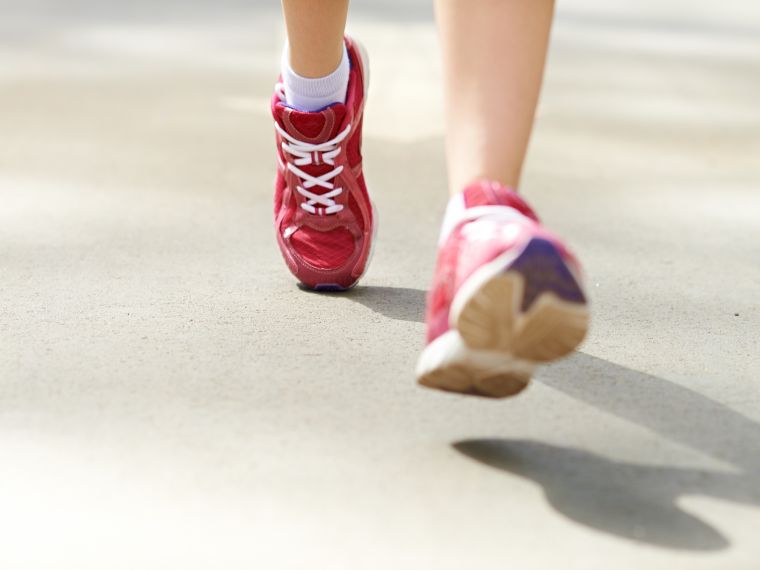Exercise isn’t just good for you—it can be life-changing, especially if you have diabetes. Regular workouts can lower your blood sugar and blood pressure, boost your energy, and help you sleep better.
You don’t need to do intense or high-impact exercises to reap the benefits—start small, try walking, swimming, or gentle strength training, and build a routine that works for you. Every step you take is a step toward a healthier, stronger you.
Walking for diabetes
Going for a walk is an easy way to get some exercise while enjoying fresh air, and it can also help you relax. For people with diabetes, regular walks can help manage blood sugar levels effectively. One simple strategy is to take a brisk walk for 30–40 minutes, three or four times a week. Getting started is easy—try walking Spot around the neighborhood instead of driving to the store. Tracking your steps and progress can be both satisfying and motivating once it becomes a habit.
Swimming to balance blood sugar naturally
Swimming is a low-impact aerobic exercise that’s easy on your joints while giving your whole body a workout.It strengthens both upper and lower body muscles, boosts heart health, supports weight loss, and can even help lower cholesterol and regulate blood sugar. If you have diabetes, make sure to let the lifeguard know before you start. Dive in today—every lap you swim is a step toward a healthier, stronger you!
Control diabetes with yoga
Yoga has been practiced for over 5,000 years for a reason—it’s a gentle, low-impact workout that can make you stronger, more flexible, and improve your balance. Focusing on poses, movements, and mindful breathing can reduce stress, build muscle, and help keep your blood sugar levels in check.
Basic yoga poses to help control diabetes:
1. Tadasana
- Stand tall with feet together, grounding evenly through both legs. Bring your palms together at the chest or extend arms overhead.
- Benefits: Improves posture, enhances circulation, and encourages mindful breathing.
2. Vrikshasana
- Balance on one leg, placing the sole of the other foot on the inner thigh. Hands can rest at the heart center or reach upward.
- Benefits: Strengthens balance, sharpens focus, and reduces stress.
3. Bhujangasana
- Lie face down, place palms under shoulders, and gently lift the chest while keeping the pelvis grounded.
- Benefits: Stimulates the pancreas, aids insulin regulation, and strengthens the spine.
4. Paschimottanasana
- Sit with legs extended, hinge forward from the hips, and reach toward the feet while keeping the spine long.
- Benefits: Stretches the spine and hamstrings, stimulates the liver and kidneys, and supports digestion.
5. Setu Bandhasana
- Lie on your back with knees bent and feet hip-width apart. Lift the hips toward the ceiling while pressing the feet into the mat.
- Benefits: Improves blood circulation, strengthens the back and glutes, and supports cardiovascular health.
6. Shavasana
- Lie flat on your back with arms relaxed at your sides, palms facing up. Close your eyes and allow the body to fully relax.
- Benefits: Promotes deep relaxation, lowers cortisol levels, and helps prevent stress-related blood sugar spikes.
Practicing these poses for 20–30 minutes daily, combined with deep, controlled breathing, can:
- Support healthy blood sugar management.
- Reduce stress and anxiety.
- Improve circulation, flexibility, and overall well-being.
Start incorporating yoga into your routine today and feel the difference in both body and mind!
4-7-8 Breathing Technique
4-7-8 Breathing Technique – A natural way to calm your body and support healthy blood sugar. This technique activates the parasympathetic nervous system, helping the body relax and reducing stress-related glucose spikes. Over time, it can be a simple yet powerful tool to support healthy blood sugar management.
Chair-Based resistance training (Ideal for adults 60+)
These gentle yet effective exercises can be done from the comfort of a chair, making them safe and accessible while still providing meaningful health benefits. Regular practice helps improve strength, mobility, and can also support healthier blood sugar levels by enhancing insulin sensitivity.
- Chair push-ups: 8–10 repetitions
- Seated leg extensions: 10–15 repetitions
- Seated arm circles with light weights: 15–20 repetitions
- Aim to complete this routine three times per week, with each session lasting just 15–20 minutes.
Daily Functional Activities
Don’t worry if traditional workouts aren’t your preference. Everyday functional activities—such as climbing stairs or gardening—can provide both cardiovascular and strength-training benefits.
Gardening, in particular, engages multiple muscle groups: walking, kneeling, and bending promote circulation and help regulate blood sugar, while digging, lifting, and raking build strength and support bone health. Plus, spending time outdoors helps lower stress levels, which is especially important for diabetes management and overall wellness.
No matter your fitness level, there are many effective options to help you stay active and take control of your diabetes.
Follow Fanpage 365 Days Healthy

